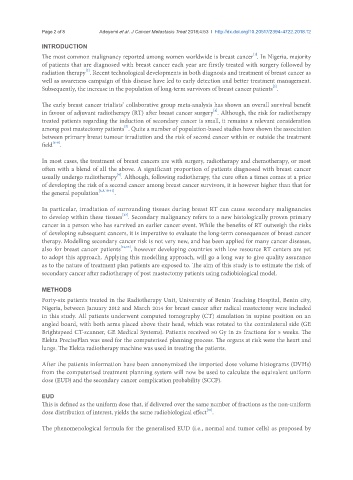Page 631 - Read Online
P. 631
Page 2 of 8 Adeyemi et al. J Cancer Metastasis Treat 2018;4:53 I http://dx.doi.org/10.20517/2394-4722.2018.12
INTRODUCTION
[1]
The most common malignancy reported among women worldwide is breast cancer . In Nigeria, majority
of patients that are diagnosed with breast cancer each year are firstly treated with surgery followed by
[2]
radiation therapy . Recent technological developments in both diagnosis and treatment of breast cancer as
well as awareness campaign of this disease have led to early detection and better treatment management.
[3]
Subsequently, the increase in the population of long-term survivors of breast cancer patients .
The early breast cancer trialists’ collaborative group meta-analysis has shown an overall survival benefit
[4]
in favour of adjuvant radiotherapy (RT) after breast cancer surgery . Although, the risk for radiotherapy
treated patients regarding the induction of secondary cancer is small, it remains a relevant consideration
[5]
among post mastectomy patients . Quite a number of population-based studies have shown the association
between primary breast tumour irradiation and the risk of second cancer within or outside the treatment
[6-8]
field .
In most cases, the treatment of breast cancers are with surgery, radiotherapy and chemotherapy, or most
often with a blend of all the above. A significant proportion of patients diagnosed with breast cancer
[9]
usually undergo radiotherapy . Although, following radiotherapy, the cure often a times comes at a price
of developing the risk of a second cancer among breast cancer survivors, it is however higher than that for
the general population [6,8,10-12] .
In particular, irradiation of surrounding tissues during breast RT can cause secondary malignancies
[13]
to develop within these tissues . Secondary malignancy refers to a new histologically proven primary
cancer in a person who has survived an earlier cancer event. While the benefits of RT outweigh the risks
of developing subsequent cancers, it is imperative to evaluate the long-term consequences of breast cancer
therapy. Modelling secondary cancer risk is not very new, and has been applied for many cancer diseases,
also for breast cancer patients [14,15] , however developing countries with low resource RT centers are yet
to adopt this approach. Applying this modelling approach, will go a long way to give quality assurance
as to the nature of treatment plan patients are exposed to. The aim of this study is to estimate the risk of
secondary cancer after radiotherapy of post mastectomy patients using radiobiological model.
METHODS
Forty-six patients treated in the Radiotherapy Unit, University of Benin Teaching Hospital, Benin city,
Nigeria, between January 2012 and March 2014 for breast cancer after radical mastectomy were included
in this study. All patients underwent computed tomography (CT) simulation in supine position on an
angled board, with both arms placed above their head, which was rotated to the contralateral side (GE
Brightspeed CT-scanner, GE Medical Systems). Patients received 50 Gy in 25 fractions for 5 weeks. The
Elekta PrecisePlan was used for the computerised planning process. The organs at risk were the heart and
lungs. The Elekta radiotherapy machine was used in treating the patients.
After the patients information have been annonymized the imported dose volume histograms (DVHs)
from the computerised treatment planning system will now be used to calculate the equivalent uniform
dose (EUD) and the secondary cancer complication probability (SCCP).
EUD
This is defined as the uniform dose that, if delivered over the same number of fractions as the non-uniform
[16]
dose distribution of interest, yields the same radiobiological effect .
The phenomenological formula for the generalised EUD (i.e., normal and tumor cells) as proposed by

